Untitled 7, 26 December 2019 is part of Luvuyo Equiano Nyawose’s eBhish’ exhibition, which shows at Blank Projects in Cape Town until 21 August. Photos: Luvuyo Equiano Nyawose
IsiZulu has mapped its understanding of “ulwandle” as ambiguous, inferring “the seas” and alluding “to the outside [ngaphandle] or the wild”. In his eBhish’ thesis, Luvuyo Equiano Nyawose explains the etymology further, saying “the word endle presupposes that which cannot be contained or controlled … ” Jack Halberstam, in parallel, frames “wildness” as an epistemological opportunity; “a form of disorder that will not submit to rule, a mode of unknowing, a resistant ontology and a fantasy of life beyond the human.”
It is notable that, in ulwandle, the sea’s point of human access — “beach”, ibhish’, is overlooked. For centuries, isiZulu did not describe this point as a special noun or a place of difference, separate from broader landscape belonging. Thus, in visiting ulwandle, one goes to the seas, the outsides, the wilds, all of which are operable independent of our experiences of them.
I’ve been interested for some time in matter and matters, like ulwandle, that are characterised by their bigness, their vagueness, their insistence on holding far more space than content; matter and matters that refuse to commit to differentiation and sustain unspoken potential through opacity and openness. Wild matter, Queer matter, Black matter: the stuff that exceeds colonial, apartheid and democratic order; the stuff of the undercommons, the chosen family, the seas …
eBhish’ seems to suggest that it may be possible for the camera (a tool better known for its taxonomic abuses) to enact the motion and unknowability of living matter. Immersed in the spiritual, cultural and social continuities that flow through and with seawater, the images themselves swim, de-zoning the idea of the “beach” and its imbued racial programme.
Immersion
Although composition is important, the act of swimming whilst documenting is key. The photographic process becomes fluid, like a performance. — Nyawose, eBhish’
In Untitled 20, taken on 1 January 2020, a child occupies the right hemisphere of the black-and-white image, their emergence from underwater palpable in the deep inhale of a widely opened mouth. The breathless kid is in the seas, among its many swimmers, all occupied in the free-motion body activity of waves and waviness. With its soft focus reminiscent of only-just-reopened eyes and the salty splashes that litter its busy scene, the photo seems to itself have just come up for air. We are immediately made aware of Nyawose, the liquid photographer who, although burdened with a camera, is more committed to this moment than to its representation. Image and maker are equally immersed, waist-deep in the Indian Ocean, as they have been year after year ebhish’ lase Thekwini.
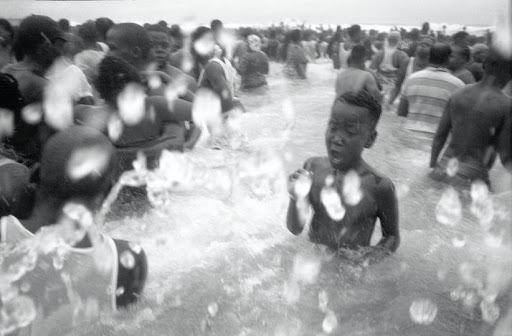 Untitled 20, (January 1st, 2020), 2021
Untitled 20, (January 1st, 2020), 2021
Artist Carlos Amorales’s “liquid archive” project reflects the constant transformation and open-endedness of his practice. In eBhish’, the “liquid archive” is applied as a refusal of the historically dominant documentation of “white leisure” at South African beaches. The images form a disobedient and unreliable archive, making no attempt to “fill gaps”, and are occupied in a project that acknowledges Black oceanic presence eThekwini. In this watery documentation of public holiday living, there is an undoing and a fluid reorganising of time and space at the beach, which both ruptures and exceeds its history of colonial administration.
Zoning (and loss)
The loss that marks ownership, specifically the ownership of private property, the loss of sharing, the loss of the earth and the consequent making of the world, is simultaneously the misapprehension that what is privatised is empty and will be filled by ownership itself, by properties, by properties placed into it. — Fred Moten and Stefano Harney, All Incomplete, 2021
Although separate beach legislation was made official in South Africa only through changes to the apartheid Separate Amenities Act in 1960, beaches (and land generally) have long been constructed by forces of patriarchal white-supremacy, or “ownership”. These forces are noted by Moten and Harney within the framework of “logistics”, describable as “the science of whiteness in/as the science of loss”, stripping space of everything but its potential to be property, to be owned.
The 1923 Native Urban Areas Act, extending long-established, land-focused settler domination, relegated so-called natives to separate locations. Their presence in wealthier, more arable, and more infrastructured “white areas”, including beaches, was allowed only when their purpose was to provide labour.
In one instance of lasting unconstitutionality, it was only in 2020 that a particularly nasty 1927 colonial “customary” law, establishing the husband’s ownership of all matrimonial assets in pre-1988 (racially) black marriages, was scrapped. This is just one of regressive patriarchal elements relating to inheritance and succession within South African customary law, which should not be seen as an organic jurisprudence of “traditional” Southern African Black cultural life. Instead, it should be recognised as part of the colonial and apartheid projects’ invention of bantustans as separately operable “nations”, for fulfilment of its own capitalist agenda.
In such legislatory instances, we recognise the colonised body — the Black body, collective — as historically and ideologically relegated to the underbelly of capitalist reproduction, as the labouring body. Women’s bodies, particularly those racialised as black under apartheid law, have not only taken on this racial-symbolic status as labouring bodies, but legally, domestically, privately and familially have been constructed as ownable bodies, without themselves possessing the capacity to own.
Through colonial doctrine, space itself — like land and sea — has also been administered by the terrors of whiteness and patriarchy. Historic segregation has ensured that spaces of leisure (thus, “leisurers” themselves) are signified through and policed by whiteness.
The apartheid Witchcraft Suppression Act of 1957 rendered non-Western, Black spiritualities as illegal, flattening and falsifying a multiplicity of spiritual cultural practices into “witchcraft”, and criminalising spiritual practitioners, healers and sangomas. The law was particularly nefarious when it came to the ocean, rendering various Nguni cultural, religious and metaphysical work facilitated beside, inside and through sea presence illegal. In this history, the brutality of leisure space is made visible, revealing itself as contingent on forms of Black repression. In enacting a force of separation between Black people and water-based spiritual life, the law designated the beach as a space enforcing double-consciousness as a right of passage, flattening its former plurality to the one-dimensional product value of “leisure”.
De-zoning!
Sea water is often, and historically, understood plurally in Nguni cultures as a cleanser, protector, healer and, importantly, a connective technology weaving ancestral and terrestrial worlds together.
Untitled 22, a quiet colour photograph of deep compositional acuity, shows the back of a figure in rolled-up red pants stooped over and collecting seawater in two large plastic bottles. Whether for sale or for the collector’s own purposes, the ocean water here exceeds its professionalised status as leisuring matter of the colonial beach. The act of collection itself is a spatial reading of ulwandle, the seas, that recognises their uncompromising wildness, power and unknowability. The seas are very old and very Queer. They precede and exceed the beach.
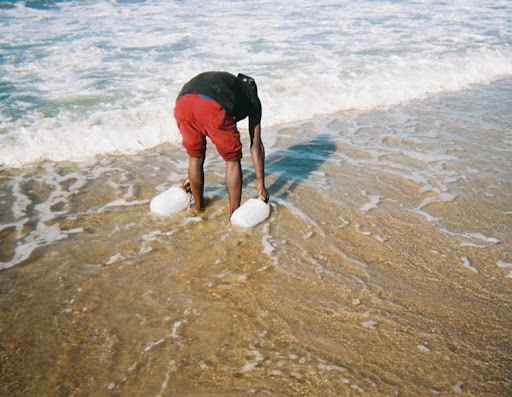 Untitled 22 (April 2019), 2021
Untitled 22 (April 2019), 2021
Through water, which comprises the majority of our living body matter, we are connected to all life; animated in our temporary, material existence by a liquid that has occupied and will occupy countless more bodies. Water is the shortcut towards recognition of matter’s constant solution and dissolution, our infinite mutability and changeability, and our presence as ever-unresolved, Queer, and always disappearing.
Holding
My reading of eBhish’ is an attempt to mimic the images’ liquid motion, guided by the loose, uncontained nature of ulwandle, and acting beyond the oxymoronic notion of “black leisure”.
In my view, when we go ebhish’, it’s spirituality in motion. When we congregate in groups emanzini there is an interplay of leisure and metaphysical reignition: black people collectively traversing physical and spiritual terrain. This is a spatial-temporal dynamic force in action, enjoyment and fun underlaced by spiritual reconfiguration. To the common eye this looks like leisure, but there is an unnameable, finer evocation. — Nyawose
My eyes seem to swim, overwhelmed by the amount of holding in this body of work — cuddles, hand-holds and arms around … Untitled 1, taken on 16 December 2019, shows a parental figure in profile, faced out towards the sea and encased in the carriage and clinging of two small kids. One is a bit bigger, draped over their shoulders, with arms wrapped tightly around their head. The other, tiny one is safely locked in big arms, head nestled in neck, and small, chubby hand placed softly. Asleep, or at least, content. The waistband of the parent’s shorts is used clumsily as storage for flip-flops, facilitating the feeling of their feet in wet sand. A backgrounded crowd seems to hum with bodies at play, at rest and in action, making the still, warm silence of the three all the more profound.
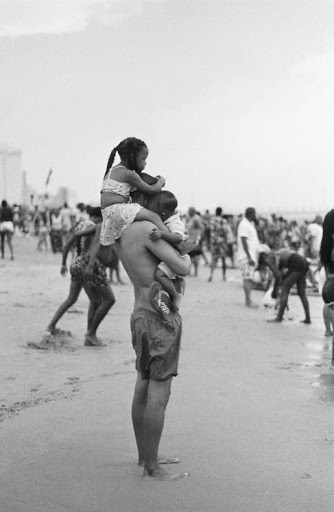 Untitled 1 (December 16th 2019), 2021
Untitled 1 (December 16th 2019), 2021
The family are not quite “at leisure”, and the scene is somehow not just “at the beach”. This is not a static moment of recreation — it melts the taxonomic frame, demanding liquid, de-analytic interaction, and resisting the impulsive liberal declaration that “representation matters”. The three’s intimacy is uninvested in either side of the antiblack dialectic of labour and leisure and its violent racial constructions of space and bodies. Nyawose’s “finer evocation” here, much like the relentless rhythm and motion of tides and waves, is in non-adherence to leisure’s performativity. There is easiness here, in the comfort of mutual holding; the ecosystems of love sustained by improvised entanglements.
Reading (not gazing)
Instead of “beaching” — an act we could analyse as adherence to colonial spatial zoning — Nyawose’s presence mimics, or acts with, the ocean landscape. But in Untitled 8 and 9 he snaps two moments of selfies-in-action, gently reminding us of the inevitably interventionist and inorganic nature of photographic capture. In both images the selfie photographers stand similarly, looking up into their highly angled phone cameras. The photographer of Untitled 9 uses a selfie stick, their smiling pout foregrounding a similar background of water-immersed kids in action. In these moments of photographed-photographing, we note that even watery capture is not devoid of the constructed nature of photographic writing.
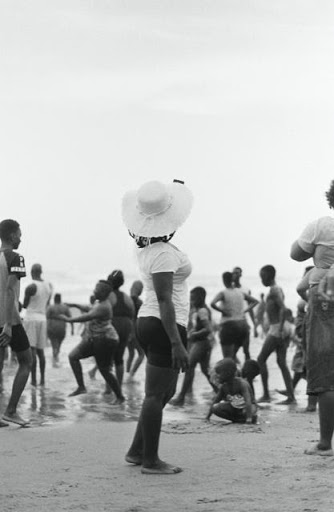 Untitled 8 (December 16th 2019), 2021.
Untitled 8 (December 16th 2019), 2021.
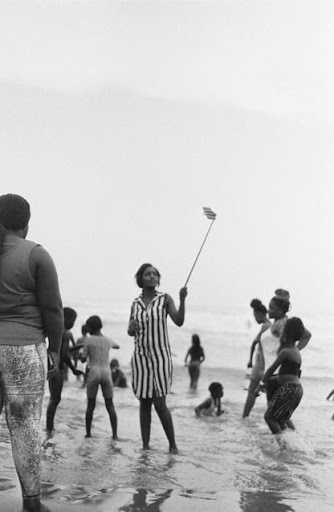 Untitled 9 (December 16th 2019), 2021.
Untitled 9 (December 16th 2019), 2021.
Thus, our reading of the work must collaborate with its various photographic escape attempts, informed by the images’ liquid motion and rooted in a broader decolonial recognition of space and matter as de-zoned. “The beach”, a temporary condition of colonial and human intervention, will always return to the seas; thus its “archive” should reflect this liquid waviness.




In the video work, eBhish’, a number of perspectives are visualised in motion, authorial drone aerial views mixing with, and transforming into, immersed, wetter points-of-view. The video seems to meditate on the tension that arises between space and people, and the taxonomic forces of coloniality. Drone imagery, reminiscent of Google Earth and the cold language of GIS mapping, is at odds with the warmth of familial social life. It turns bodies into specks who appear to congregate obediently around the colonial architectures of beachside leisure.
Drones are unmoved by the chubby, clinging hands of babies in oversized hats, caught between wide-eyed giggles and the absurd feeling of summer sand on their toes. They do not recognise the languages of holding, bubbled underwater exhales or the special feeling of swimming: immersion in the matter of one’s own making. The drone zones the beach. And Nyawose’s soft, camera-wielding step enacts its de-zoning.
Unpressured by notions like “holiday”, which prescribe productive purpose to place, an ulwandle-premised analysis of beach land insists on revoking its capitalist-spatial differentiation. eBhish’ pursues this commitment, immersed in recognising the waviness, mobility and uncontained character that defines our — and all — matter as operable beyond, and in excess of, colonial zoning.
eBhish’ runs at Blank Projects in Cape Town until 21 August.
This is an edited version of an essay commissioned for a publication exploring Luvuyo Equiano Nyawose’s eBhish’ and broader reflections on Black oceanic presence.